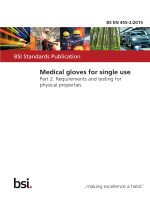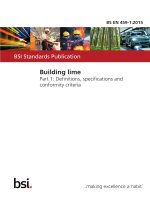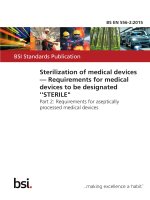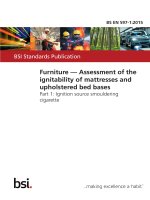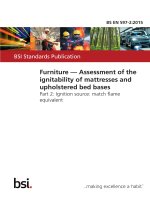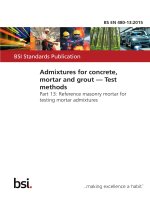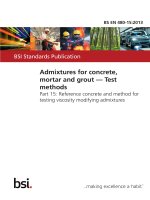Bsi bs en 62047 15 2015
Bạn đang xem bản rút gọn của tài liệu. Xem và tải ngay bản đầy đủ của tài liệu tại đây (1.35 MB, 18 trang )
BS EN 62047-15:2015
BSI Standards Publication
Semiconductor devices —
Micro-electromechanical
devices
Part 15: Test method of bonding strength
between PDMS and glass
BRITISH STANDARD
BS EN 62047-15:2015
National foreword
This British Standard is the UK implementation of EN 62047-15:2015. It is
identical to IEC 62047-15:2015.
The UK participation in its preparation was entrusted to Technical
Committee EPL/47, Semiconductors.
A list of organizations represented on this committee can be obtained on
request to its secretary.
This publication does not purport to include all the necessary provisions of
a contract. Users are responsible for its correct application.
© The British Standards Institution 2015.
Published by BSI Standards Limited 2015
ISBN 978 0 580 70802 2
ICS 31.080.99
Compliance with a British Standard cannot confer immunity from
legal obligations.
This British Standard was published under the authority of the
Standards Policy and Strategy Committee on 31 July 2015.
Amendments/corrigenda issued since publication
Date
Text affected
EUROPEAN STANDARD
EN 62047-15
NORME EUROPÉENNE
EUROPÄISCHE NORM
July 2015
ICS 31.080.99
English Version
Semiconductor devices - Micro-electromechanical devices - Part
15: Test method of bonding strength between PDMS and glass
(IEC 62047-15:2015)
Dispositifs à semiconducteurs - Dispositifs
microélectromécaniques - Partie 15: Méthode d'essai de la
résistance de collage entre PDMS et verre
(IEC 62047-15:2015)
Halbleiterbauelemente - Bauelemente der
Mikrosystemtechnik - Teil 15: Prüfverfahren zur
Bondqualität zwischen PDMS und Glas
(IEC 62047-15:2015)
This European Standard was approved by CENELEC on 2015-04-09. CENELEC members are bound to comply with the CEN/CENELEC
Internal Regulations which stipulate the conditions for giving this European Standard the status of a national standard without any alteration.
Up-to-date lists and bibliographical references concerning such national standards may be obtained on application to the CEN-CENELEC
Management Centre or to any CENELEC member.
This European Standard exists in three official versions (English, French, German). A version in any other language made by translation
under the responsibility of a CENELEC member into its own language and notified to the CEN-CENELEC Management Centre has the
same status as the official versions.
CENELEC members are the national electrotechnical committees of Austria, Belgium, Bulgaria, Croatia, Cyprus, the Czech Republic,
Denmark, Estonia, Finland, Former Yugoslav Republic of Macedonia, France, Germany, Greece, Hungary, Iceland, Ireland, Italy, Latvia,
Lithuania, Luxembourg, Malta, the Netherlands, Norway, Poland, Portugal, Romania, Slovakia, Slovenia, Spain, Sweden, Switzerland,
Turkey and the United Kingdom.
European Committee for Electrotechnical Standardization
Comité Européen de Normalisation Electrotechnique
Europäisches Komitee für Elektrotechnische Normung
CEN-CENELEC Management Centre: Avenue Marnix 17, B-1000 Brussels
© 2015 CENELEC All rights of exploitation in any form and by any means reserved worldwide for CENELEC Members.
Ref. No. EN 62047-15:2015 E
BS EN 62047-15:2015
EN 62047-15:2015
European foreword
The text of document 47F/208/FDIS, future edition 1 of IEC 62047-15, prepared by SC 47F
“Microelectromechanical systems” of IEC/TC 47 “Semiconductor devices" was submitted to the
IEC-CENELEC parallel vote and approved by CENELEC as EN 62047-15:2015.
The following dates are fixed:
•
latest date by which the document has to be
implemented at national level by
publication of an identical national
standard or by endorsement
(dop)
2016-01-10
•
latest date by which the national
standards conflicting with the
document have to be withdrawn
(dow)
2018-04-09
Attention is drawn to the possibility that some of the elements of this document may be the subject of
patent rights. CENELEC [and/or CEN] shall not be held responsible for identifying any or all such
patent rights.
Endorsement notice
The text of the International Standard IEC 62047-15:2015 was approved by CENELEC as a European
Standard without any modification.
2
BS EN 62047-15:2015
EN 62047-15:2015
Annex ZA
(normative)
Normative references to international publications
with their corresponding European publications
The following documents, in whole or in part, are normatively referenced in this document and are
indispensable for its application. For dated references, only the edition cited applies. For undated
references, the latest edition of the referenced document (including any amendments) applies.
NOTE 1 When an International Publication has been modified by common modifications, indicated by (mod), the relevant
EN/HD applies.
NOTE 2 Up-to-date information on the latest versions of the European Standards listed in this annex is available here:
www.cenelec.eu.
Publication
IEC 62047-9
Year
-
Title
EN/HD
Semiconductor devices - MicroEN 62047-9
electromechanical devices -- Part 9: Wafer
to wafer bonding strength measurement for
MEMS
Year
-
3
–2–
BS EN 62047-15:2015
IEC 62047-15:2015 © IEC 2015
CONTENTS
FOREWORD ........................................................................................................................... 3
1
Scope .............................................................................................................................. 5
2
Normative references ...................................................................................................... 5
3
Terms and definitions ...................................................................................................... 5
4
Testing method ................................................................................................................ 6
4.1
Visual test ............................................................................................................... 6
4.1.1
General ........................................................................................................... 6
4.1.2
Equipment ....................................................................................................... 6
4.1.3
Procedure ........................................................................................................ 6
4.1.4
Visual test results ............................................................................................ 6
4.2
Bonding strength test .............................................................................................. 6
4.2.1
General ........................................................................................................... 6
4.2.2
Sample preparation ......................................................................................... 7
4.2.3
Procedure ........................................................................................................ 7
4.2.4
Result of blister test ......................................................................................... 8
4.3
Contact angle measurement ................................................................................... 8
4.3.1
General ........................................................................................................... 8
4.3.2
Equipment ....................................................................................................... 8
4.3.3
Procedure ........................................................................................................ 8
4.3.4
Result of test ................................................................................................... 9
4.4
Hermeticity test ....................................................................................................... 9
4.4.1
General ........................................................................................................... 9
4.4.2
Equipment ....................................................................................................... 9
4.4.3
Procedure ...................................................................................................... 10
4.4.4
Result of test ................................................................................................. 10
Bibliography .......................................................................................................................... 11
Figure 1 – Blister mask ........................................................................................................... 7
Figure 2 – PDMS blister .......................................................................................................... 8
Figure 3 – Contact angle measurement of water drop on PDMS .............................................. 9
Figure 4 – Test set-up for hermeticity .................................................................................... 10
Table 1 − Result of visual test ................................................................................................. 6
BS EN 62047-15:2015
IEC 62047-15:2015 © IEC 2015
–3–
INTERNATIONAL ELECTROTECHNICAL COMMISSION
____________
SEMICONDUCTOR DEVICES –
MICRO-ELECTROMECHANICAL DEVICES –
Part 15: Test method of bonding
strength between PDMS and glass
FOREWORD
1) The International Electrotechnical Commission (IEC) is a worldwide organization for standardization comprising
all national electrotechnical committees (IEC National Committees). The object of IEC is to promote
international co-operation on all questions concerning standardization in the electrical and electronic fields. To
this end and in addition to other activities, IEC publishes International Standards, Technical Specifications,
Technical Reports, Publicly Available Specifications (PAS) and Guides (hereafter referred to as “IEC
Publication(s)”). Their preparation is entrusted to technical committees; any IEC National Committee interested
in the subject dealt with may participate in this preparatory work. International, governmental and nongovernmental organizations liaising with the IEC also participate in this preparation. IEC collaborates closely
with the International Organization for Standardization (ISO) in accordance with conditions determined by
agreement between the two organizations.
2) The formal decisions or agreements of IEC on technical matters express, as nearly as possible, an international
consensus of opinion on the relevant subjects since each technical committee has representation from all
interested IEC National Committees.
3) IEC Publications have the form of recommendations for international use and are accepted by IEC National
Committees in that sense. While all reasonable efforts are made to ensure that the technical content of IEC
Publications is accurate, IEC cannot be held responsible for the way in which they are used or for any
misinterpretation by any end user.
4) In order to promote international uniformity, IEC National Committees undertake to apply IEC Publications
transparently to the maximum extent possible in their national and regional publications. Any divergence
between any IEC Publication and the corresponding national or regional publication shall be clearly indicated in
the latter.
5) IEC itself does not provide any attestation of conformity. Independent certification bodies provide conformity
assessment services and, in some areas, access to IEC marks of conformity. IEC is not responsible for any
services carried out by independent certification bodies.
6) All users should ensure that they have the latest edition of this publication.
7) No liability shall attach to IEC or its directors, employees, servants or agents including individual experts and
members of its technical committees and IEC National Committees for any personal injury, property damage or
other damage of any nature whatsoever, whether direct or indirect, or for costs (including legal fees) and
expenses arising out of the publication, use of, or reliance upon, this IEC Publication or any other IEC
Publications.
8) Attention is drawn to the Normative references cited in this publication. Use of the referenced publications is
indispensable for the correct application of this publication.
9) Attention is drawn to the possibility that some of the elements of this IEC Publication may be the subject of
patent rights. IEC shall not be held responsible for identifying any or all such patent rights.
International Standard IEC 62047-15 has been prepared by subcommittee 47F: Microelectromechanical systems, of IEC technical committee 47: Semiconductor devices.
The text of this standard is based on the following documents:
FDIS
Report on voting
47F/208/FDIS
47F/213/RVD
Full information on the voting for the approval of this standard can be found in the report on
voting indicated in the above table.
This publication has been drafted in accordance with the ISO/IEC Directives, Part 2.
–4–
BS EN 62047-15:2015
IEC 62047-15:2015 © IEC 2015
A list of all parts in the IEC 62047 series, published under the general title Semiconductor
devices – Micro-electromechanical devices, can be found on the IEC website.
The committee has decided that the contents of this publication will remain unchanged until
the stability date indicated on the IEC web site under "" in the data
related to the specific publication. At this date, the publication will be
•
reconfirmed,
•
withdrawn,
•
replaced by a revised edition, or
•
amended.
IMPORTANT – The 'colour inside' logo on the cover page of this publication indicates
that it contains colours which are considered to be useful for the correct
understanding of its contents. Users should therefore print this document using a
colour printer.
BS EN 62047-15:2015
IEC 62047-15:2015 © IEC 2015
–5–
SEMICONDUCTOR DEVICES –
MICRO-ELECTROMECHANICAL DEVICES –
Part 15: Test method of bonding strength between PDMS and glass
1
Scope
This part of IEC 62047 describes test method for bonding strength between poly dimethyl
siloxane (PDMS) and glass. Silicone-based rubber, PDMS, is used for building of chip-based
microfluidic devices fabricated using lithography and replica moulding processes. The
problem of bonding strength is mainly for high pressure applications as in the case of certain
peristaltic pump designs where an off chip compressed air supply is used to drive the fluids in
micro channels created by a twin layer, one formed by bondage between glass with replica
moulded PDMS and another between PDMS and PDMS. Also, in case of systems having
pneumatic microvalves, a relatively high level of bonding particularly between two replica
moulded layers of PDMS becomes quite necessary. Usually there is a leakage and debonding
phenomena between interface of bonded areas, which causes unstability and shortage of
lifetime for MEMS devices. This standard specifies general procedures on bonding test of
PDMS and glass chip.
2
Normative references
The following documents, in whole or in part, are normatively referenced in this document and
are indispensable for its application. For dated references, only the edition cited applies. For
undated references, the latest edition of the referenced document (including any
amendments) applies.
IEC 62047-9, Semiconductor devices – Micro-electromechanical devices – Part 9: Wafer to
wafer bonding strength measurement for MEMS
3
Terms and definitions
For the purposes of this document, the following terms and definitions apply.
3.1
complete bonded area
bonded wafer without void areas
3.2
hydrophilic
physical property of a molecule that can bond with water (H 2 O) through hydrogen bonding
Note 1 to entry: A definition of the term "molecule" can be found on this page:
/>Note 2 to entry: A definition of "hydrogen bond" can be found on this page:
/>
3.3
hydrophobic
property that tend to be non-polar molecules which form aggregates of like molecules in water
and analogous intramolecular interactions
BS EN 62047-15:2015
IEC 62047-15:2015 © IEC 2015
–6–
3.4
PDMS
silicone-based rubber poly dimethyl
(H 3 C) 3 SiO[Si(CH 3 ) 2 O] n Si(CH 3 ) 3
4
siloxane
having
a
chemical
formula
of
Testing method
4.1
4.1.1
Visual test
General
The visual test should be performed to confirm whether substantial other bonding tests are
required. Visual test is a simple qualitative test method.
Optical equipment shall be used to evaluate the bonding interface of glass to PDMS and
PDMS to PDMS.
4.1.2
Equipment
One or a few equipments of optical microscope, scanning acoustic microscope, scanning
electron microscope (SEM), transmittion electron microscope (TEM) and infra-red (IR) or
optical camera can be used.
4.1.3
Procedure
The procedure is as follows:
a) to observe bonding conditions using the optical microscope;
b) to measure voids areas and bubbles using images observed images by optical microscope
and IR camera.
4.1.4
Visual test results
The test results can be classified into three classes after observation based on the Key in
Table 1 for each.
Table 1 − Result of visual test
Type numbers or serial numbers of objective wafer
Good
Fair
Poor
1
2
3
Key
Good – complete bonded area larger than 95 %
Fair – complete bonded area larger than 75 %
Poor – complete bonded area larger than 50 %
4.2
4.2.1
Bonding strength test
General
The bond strength is measured using the blister test wherein a blister of 3 mm diameter is
made in PDMS using photolithography and replica moulding techniques. General
requirements are given in IEC 62047-9.
BS EN 62047-15:2015
IEC 62047-15:2015 © IEC 2015
4.2.2
–7–
Sample preparation
The masks for selective patterning are designed and printed by using a high-resolution printer
(see Figure 1).
10 mm
IEC
Figure 1 – Blister mask
The fabrication of the blister is done in two layers. The negative photoresist is spun onto a
cleaned glass wafer of 63,5 mm diameter.
The typical thickness of the resist is about 200 µm after spinning. The negative photoresist is
next patterned using the mask as shown in Figure 1. This negative is used to cast the PDMS
up to 2,5 mm thickness.
After curing the PDMS cast, pieces of size 12,7 mm × 12,7 mm are cut around the blister
shapes. These are then bonded to pieces of plain PDMS, or cleaned glass slides of similar
size by plasma treatment. For glass/PDMS bonding, the glass slides are thoroughly cleaned
by boiling in piranha solution (5:1 ratio of concentrated and 30% solution) for 3 min to 4 min
and then, repeatedly washed in DI water before plasma exposure.
4.2.3
Procedure
After fabricating the blister, an input port is attached to it using a steel pipe and a polyether
ether ketone (PEEK) tubing, which is epoxied to one of the edges (see Figure 2). A regulated
nitrogen or air supply is connected to the device.
BS EN 62047-15:2015
IEC 62047-15:2015 © IEC 2015
–8–
1
2
3
4
Ø3 mm
5
IEC
Key
1
PEEK tubing
2
Epoxy
3
Steel tube
4
Blister
5
Compressed nitrogen or air to expand the blister
Figure 2 – PDMS blister
4.2.4
Result of blister test
The pressure at which the blister starts to fail is noted down. The pressure is proportional to
the bonding strength.
4.3
4.3.1
Contact angle measurement
General
Contact angle measurement is the ideal method to characterize surface wettability and widely
used technique of loss and recovery of hydrophobicity of silicone rubbers. So, this method
can be used to accurately measure the hydrophilic characteristic of a surface for a polymer
like PDMS, whose surface properties change speedily with post exposure time.
4.3.2
Equipment
A camera of the contact angle setup should be used. Simultaneously, a separate set of GlassPDMS and PDMS-PDMS substrates exposed in the same run of the exposure tool are brought
into conformal position with each other after a similar span of time, as required to transit the
exposed wafer and put a water drop over it.
4.3.3
Procedure
For accuracy of measurement, the contact angle measurement system used in this part of
IEC 62047 is positioned close to the plasma exposure tool. This enables to capture the image
of a water droplet, dropped on the plasma treated sample within the first one minute of the
plasma exposure. Figure 3 shows the contact angle ( θ ) between the surface and a water
droplet.
BS EN 62047-15:2015
IEC 62047-15:2015 © IEC 2015
–9–
1
4
2
3
IEC
Key
1
Air
2
Water
3
PDMS
4
θ
Figure 3 – Contact angle measurement of water drop on PDMS
4.3.4
Result of test
Write down the angle ( θ ) as shown in Figure 3.
4.4
4.4.1
Hermeticity test
General
This is a kind of leakage test between PDMS and PDMS chip or PDMS and glass chip. This
test can be applied in case of having a channel in structure.
4.4.2
Equipment
Prepare for the test set-up as shown in Figure 4.
BS EN 62047-15:2015
IEC 62047-15:2015 © IEC 2015
– 10 –
1
2
3
4
5
6
7
8
IEC
Key
1
Helium gas
2
Bonded sample
3
Sealing paste
4
Glass tube
5
O-Ring
6
Leak detector
7
Leak detector
8
Pump out
Figure 4 – Test set-up for hermeticity
4.4.3
Procedure
After pumping out chamber, apply helium gas to the interface of bonded area as shown in
Figure 4. Check the leak from the leak detector in Figure 4. If there is no leak, keep pumping
out chamber until detecting the leak.
4.4.4
Result of test
Write down the chamber pressure when there is a leak for the first time.
NOTE Even though PDMS is a permeable material, checking the leakage level of bonded area gives important
criterion for the next step of fabrication process.
BS EN 62047-15:2015
IEC 62047-15:2015 © IEC 2015
– 11 –
Bibliography
Shantanu Bhattacharya, Arindom Datta, Jordan M. Berg, and Shubhra Gangopadhyay,
Studies on Surface Wettability of Poly (Dimethyl) Siloxane (PDMS) and Glass Under OxygenPlasma
Treatment
and
Correlation
With
Bond
Strength,
JOURNAL
OF
MICROELECTROMECHANICAL SYSTEMS, VOL. 14, NO. 3, JUNE 2005
_____________
This page deliberately left blank
This page deliberately left blank
NO COPYING WITHOUT BSI PERMISSION EXCEPT AS PERMITTED BY COPYRIGHT LAW
British Standards Institution (BSI)
BSI is the national body responsible for preparing British Standards and other
standards-related publications, information and services.
BSI is incorporated by Royal Charter. British Standards and other standardization
products are published by BSI Standards Limited.
About us
Revisions
We bring together business, industry, government, consumers, innovators
and others to shape their combined experience and expertise into standards
-based solutions.
Our British Standards and other publications are updated by amendment or revision.
The knowledge embodied in our standards has been carefully assembled in
a dependable format and refined through our open consultation process.
Organizations of all sizes and across all sectors choose standards to help
them achieve their goals.
Information on standards
We can provide you with the knowledge that your organization needs
to succeed. Find out more about British Standards by visiting our website at
bsigroup.com/standards or contacting our Customer Services team or
Knowledge Centre.
Buying standards
You can buy and download PDF versions of BSI publications, including British
and adopted European and international standards, through our website at
bsigroup.com/shop, where hard copies can also be purchased.
If you need international and foreign standards from other Standards Development
Organizations, hard copies can be ordered from our Customer Services team.
Subscriptions
Our range of subscription services are designed to make using standards
easier for you. For further information on our subscription products go to
bsigroup.com/subscriptions.
With British Standards Online (BSOL) you’ll have instant access to over 55,000
British and adopted European and international standards from your desktop.
It’s available 24/7 and is refreshed daily so you’ll always be up to date.
You can keep in touch with standards developments and receive substantial
discounts on the purchase price of standards, both in single copy and subscription
format, by becoming a BSI Subscribing Member.
PLUS is an updating service exclusive to BSI Subscribing Members. You will
automatically receive the latest hard copy of your standards when they’re
revised or replaced.
To find out more about becoming a BSI Subscribing Member and the benefits
of membership, please visit bsigroup.com/shop.
With a Multi-User Network Licence (MUNL) you are able to host standards
publications on your intranet. Licences can cover as few or as many users as you
wish. With updates supplied as soon as they’re available, you can be sure your
documentation is current. For further information, email
BSI Group Headquarters
389 Chiswick High Road London W4 4AL UK
We continually improve the quality of our products and services to benefit your
business. If you find an inaccuracy or ambiguity within a British Standard or other
BSI publication please inform the Knowledge Centre.
Copyright
All the data, software and documentation set out in all British Standards and
other BSI publications are the property of and copyrighted by BSI, or some person
or entity that owns copyright in the information used (such as the international
standardization bodies) and has formally licensed such information to BSI for
commercial publication and use. Except as permitted under the Copyright, Designs
and Patents Act 1988 no extract may be reproduced, stored in a retrieval system
or transmitted in any form or by any means – electronic, photocopying, recording
or otherwise – without prior written permission from BSI. Details and advice can
be obtained from the Copyright & Licensing Department.
Useful Contacts:
Customer Services
Tel: +44 845 086 9001
Email (orders):
Email (enquiries):
Subscriptions
Tel: +44 845 086 9001
Email:
Knowledge Centre
Tel: +44 20 8996 7004
Email:
Copyright & Licensing
Tel: +44 20 8996 7070
Email:
